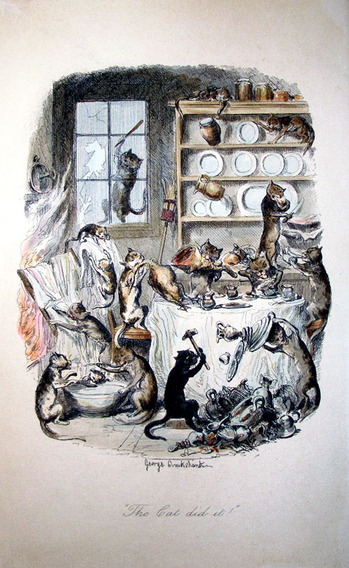George Cruikshank (1792-1878), “The Cat Did It,” in George Cruikshank’s illustrations to “The Greatest Plague of Life,” by the Brothers Mayhew (London: D. Bogue, 1847). Twelve etchings in two states. Graphic Arts Collection (GA) Oversize Kane Room Cruik 1846.61q
Henry Mayhew’s book is subtitled The Adventures of a Lady in Search of a Good Servant By One Who has been “Almost Worried to Death.” It was, in fact, Cruikshank’s cleanliness that first attracted Mayhew to him, as described in the introduction:
“How I Became Acquainted With The Artist To My Little Book.”
“When I reached Mr. Cruikshank’s door …, from the beautiful appearance that the threshold of his establishment presented, I at once knew my man. The doorstep was so sweetly white and clean that one might have been tempted to eat one’s dinner off of it, while the brass plate was as beautiful a picture as I ever remember to have seen. In that door-plate I could see the workings of a rightly constituted mind. … When the door was opened, I was delighted to find that everything within bore out the conclusion I had drawn of this great man’s character from his simple doorstep.”
“After waiting a few minutes in a delightful ante-room, I was shown into the Study, and for the first time stood face to face with that highly-talented artist and charming man, George Cruikshank, Esquire, whom, as a painter, I don’t think I go too far in calling the Constable of the day. … Nature has evidently thrown Mr. Cruikshank’s whole soul in his face; there is (if I may be allowed the expression) a fire in his eye which is quite cheerful to look at; and when he speaks, from the cordial tone of his discourse, you feel as certain, as if his bosom was laid bare to you, that his heart is in its right place. Nor can I omit to mention the picturesque look of his whiskers, which are full and remarkably handsome, and at once tell you that they have been touched by the hand of a great painter.”
